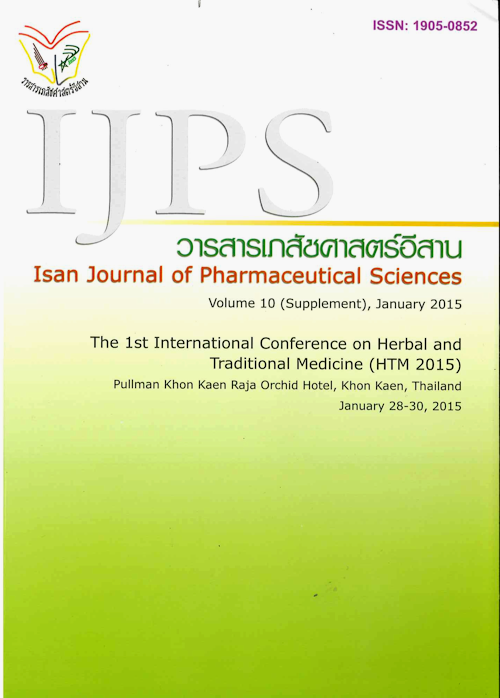Antibacterial Activities Of Essential Oil From Zingiber Cassumnar Roxb. Against Serratia marcescens, Associated With Bacterial Keratitis
Main Article Content
Abstract
Introduction: Serratia marcescens (SM) is responsible for bacterial keratitis.The occurrence of antibiotics and disinfectants resistant - SM necessitate the discovery of new anti- SM agents from natural plants leads. Methods:The antibacterial activities of essential oils from 18 medicinal plants (Zingiber cassumunar Roxb.(A), Zingiber offi cinale(B), Curcuma aromatica Salisb. (C), Chromolaena odoratum (L.) (D), Amomum bifl orum Jack (E), Citrus maxima (Burm.f).Merr.(F), Syzygium aromaticum (L.) Merr.& L.M.Perry. (G), Citrus hystrix DC. (H), Kaempferia galanga L. (I), Alpinia galangal (Linn.) Swartz (J), Cocos nucifera L.(K), Curcuma xanthorrhiza Roxb (L), Mentha cordifolia Opiz. (M), Curcuma iners Blume (N), Eucalptus globulus Labill. (O), Litsea cubeba Pers(P)., Curcuma longa L. (Q), and Citrus reticulate Blanco (R)), against 5 strains of SM, obtaining from Department of Medical Sciences Thailand Culture Collection (DMST); SM DMST4228, SM DMST 4424, SM DMST 5100, SM DMST 8845 and SM DMST 8846) were performed by using agar diffusion method (20 mg/disc). The
minimum inhibitory concentrations (MICs) of the selected oil were determined by agar dilution method. The selected oil was investigated antibacterial potency comparable with 5 antibiotics (gentamicin:GEN, chloramphenicol:Cam, erythromycin:ERY, ampicillin:Amp, and tetracyclin:Tet) by using the agar
diffusion method. Results: Among 18 essential oils, the antibacterial effect against the 5 strains of SM
revealed that A (phlai oil) possessed signifi cantly the strongest antibacterial effi cacy with the range of its inhibition zones was 9.70-20.42 mm. The oil showed higher anti- SM activities against the 5 strains than AMP and ERY did. The best MIC value of A was 5 mg/mL. Conclusion:These fi ndings indicate the possibility to use phlai oil for the topical treatment of bacterial keratitis against SM.
Article Details
In the case that some parts are used by others The author must Confirm that obtaining permission to use some of the original authors. And must attach evidence That the permission has been included
References
Wikler M A, Cockerill F., Craig W A, et al, editors. Performance standards for antimicrobial disk susceptibility tests; approved standard-ninth edition. Clinical and Laboratory Standards Institute (CLSI) document M2-A9, 2006; Jan 26(1): 7-11.
Wayne, PA, USA. Wikler M A, Cockerill F., Craig W A, et al, editors. Method for dilution antimicrobial susceptibility tests for bacteria that grow aerobically; approved standard- seven edition. Clinical and Laboratory Standards Institute (CLSI) document M7-A7, 2006; Jan 26(2):5-14.
Wayne, PA,USA.Giwanon R, Thubthimthed S, Rerk-am U, Sunthorntanasart T. Antimicrobial activity of terpinene-4-ol and sabinene. Thai. J Pharm Sci, 2000; 24:27.
Jeenapongsa R, Yoovathaworn K, Sriwatanakul M, et.al. Anti-infl ammatory activity of (E)-1-(3,4-dimethoxyphenyl) butadiene from Zingiber cassumunar Roxb. JEthanophamacol 2003; 87:143-148.
Ozaki Y, Kawahara N, Harada M. Anti-infl ammatory effect of Zingiber cassumunar Roxb. and its active principles. Chem. Pharm. Bull. 1991; 39: 2353-2356.
Parment P A. The role of Serratia marcescens in soft contact lens associated ocular infections. Acta. Ophthalmol. Scand. 1997; 75: 67-71.
Wasuwat S., Wanisorn P., Mahintorntep B., et.al. Studies on antimicrobial and antifungal activities of terpinene-4-ol extracted from Zingiber cassumunar Roxb. In: Thailand Institute of Scientific and Technological Research; Research Project No. 30-32/ Rep. No.1.1989: 1-7.
Zhou R, Zhang R, Sun Y. Innate immune regulation of Serratia marcescens-induced corneal inflammation and infection. IOVS. 2012; 53(11): 7382-7388.


